An Energy Efficient Mutual Authentication and Key Agreement Scheme Preserving Anonymity for Wireless Sensor Networks
Abstract
:1. Introduction
2. Review of Amin-Biswas’s Scheme
2.1. System Setup
2.2. Sensor Node Registration
2.3. User Registration
2.4. Login and Authentication
2.5. Dynamic Node Addition
2.6. Password Update
3. Security Analysis of Amin-Biswas’s Scheme
Known Session-Specific Temporary Information Attack
4. Proposed Improved Scheme
4.1. User Registration
4.2. Sensor Node Registration
4.3. Login
4.4. Password Change
5. Security Analysis of Our Scheme
5.1. Informal Security Analysis
5.1.1. Session Key Agreement
5.1.2. Mutual Authentication
5.1.3. Resistance to Insider Attack
5.1.4. User Anonymity
5.1.5. Resistance to Known Session-Specific Temporary Information Attack
5.1.6. Resistance to Denial-of-Service Attack
5.1.7. Resistance to Sensor Node Impersonation Attack
5.1.8. Resistance to Off-Line Password Guessing with Smart Card Breach Attack
5.2. Authentication Proof Based on the BAN Logic
5.3. Formal Security Proof
| Algorithm 1 . |
|
| Algorithm 2 . |
|
5.4. Simulation Results Using AVISPA Tool
6. Performance Analysis
7. Conclusions
Acknowledgments
Author Contributions
Conflicts of Interest
Appendix A HLPSL Implementation of the Proposed Scheme
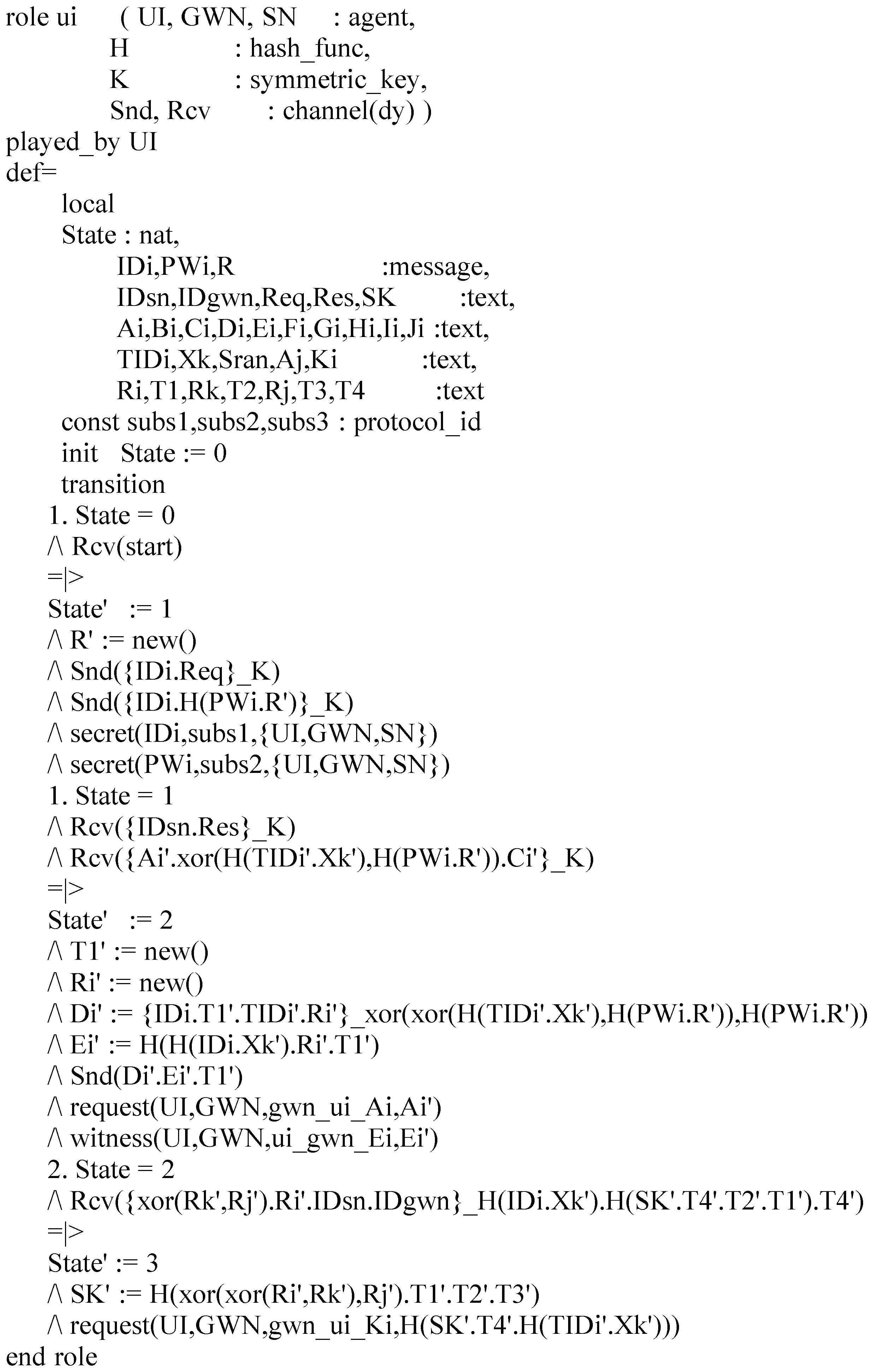
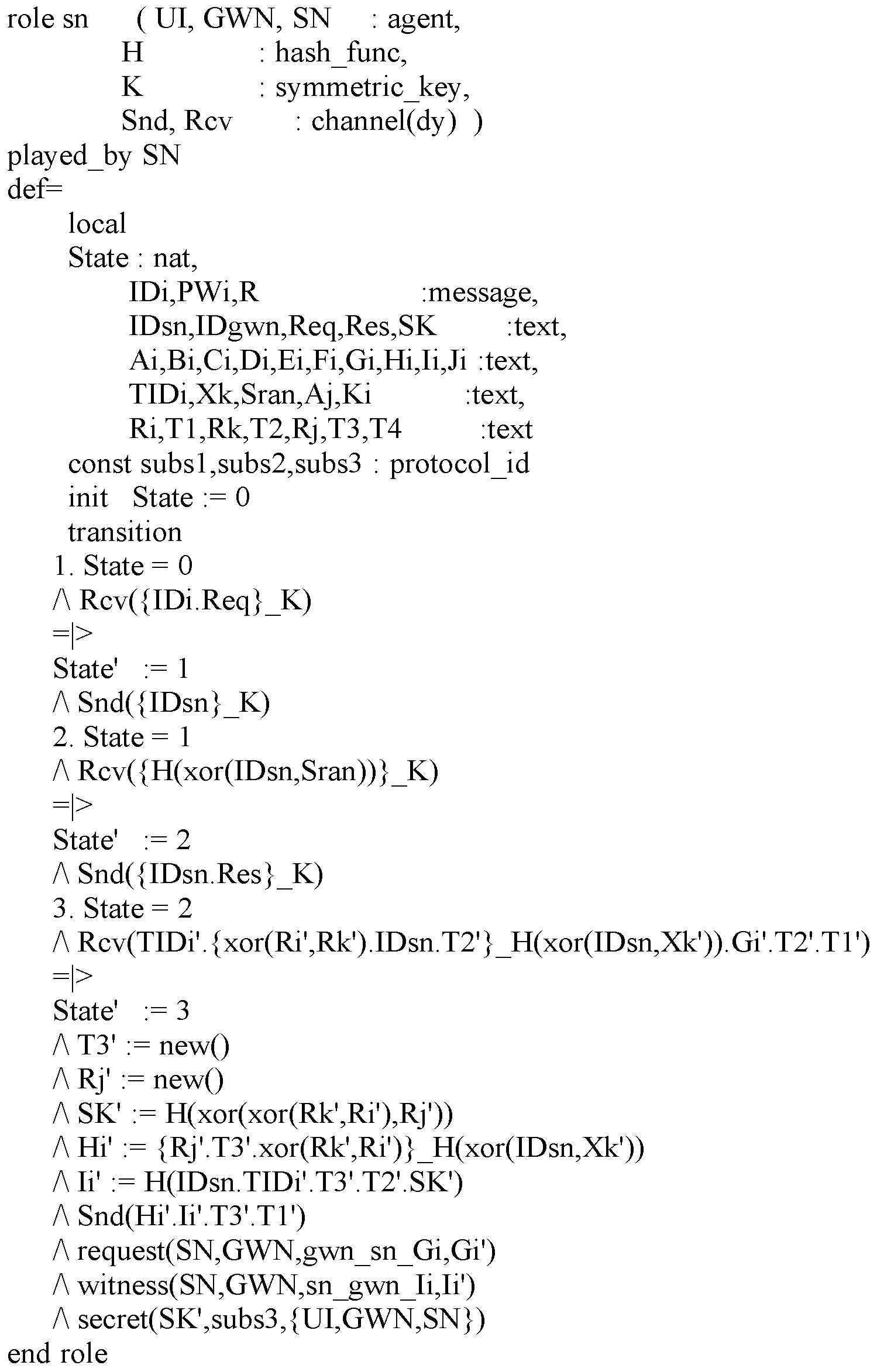
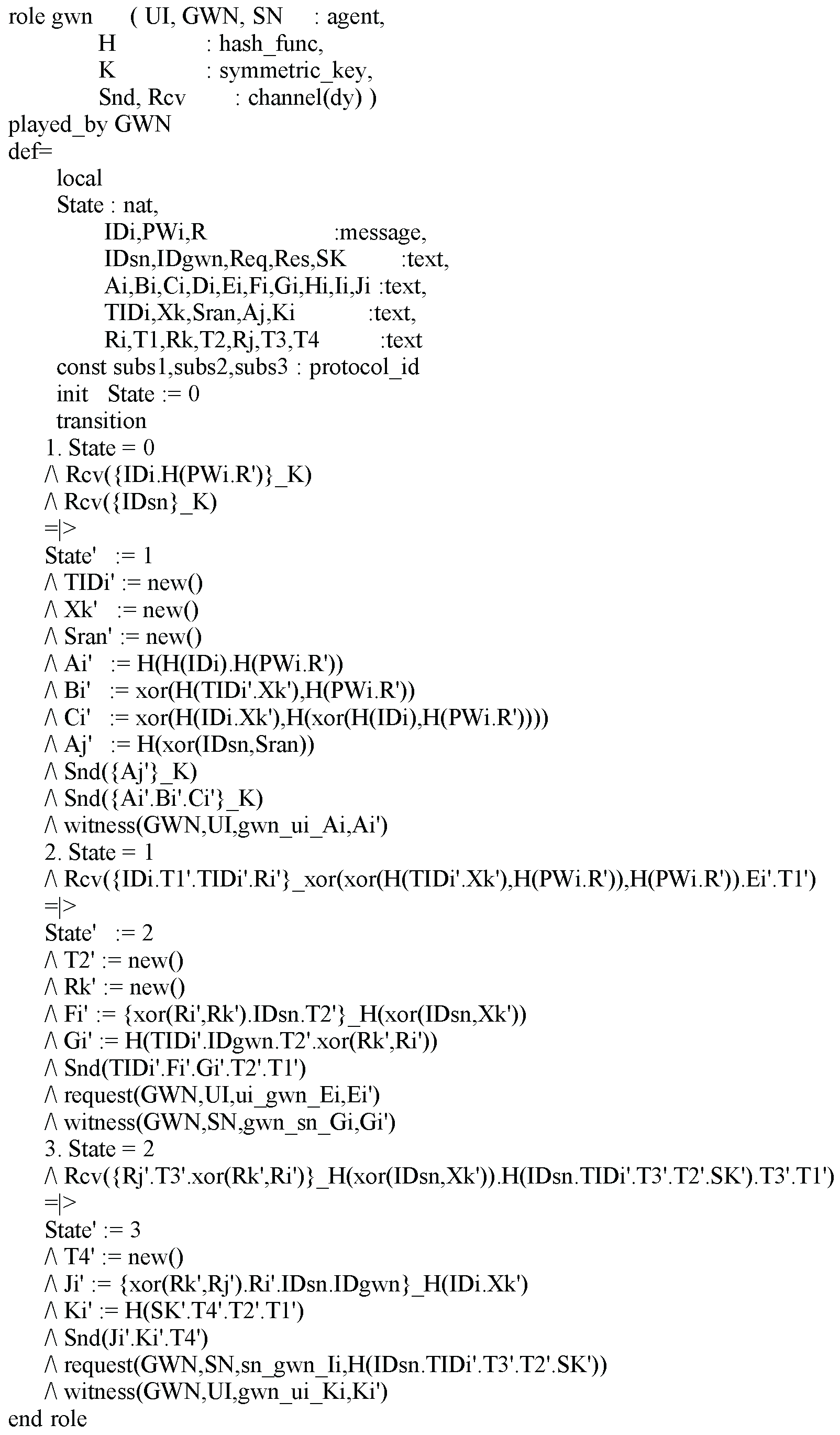
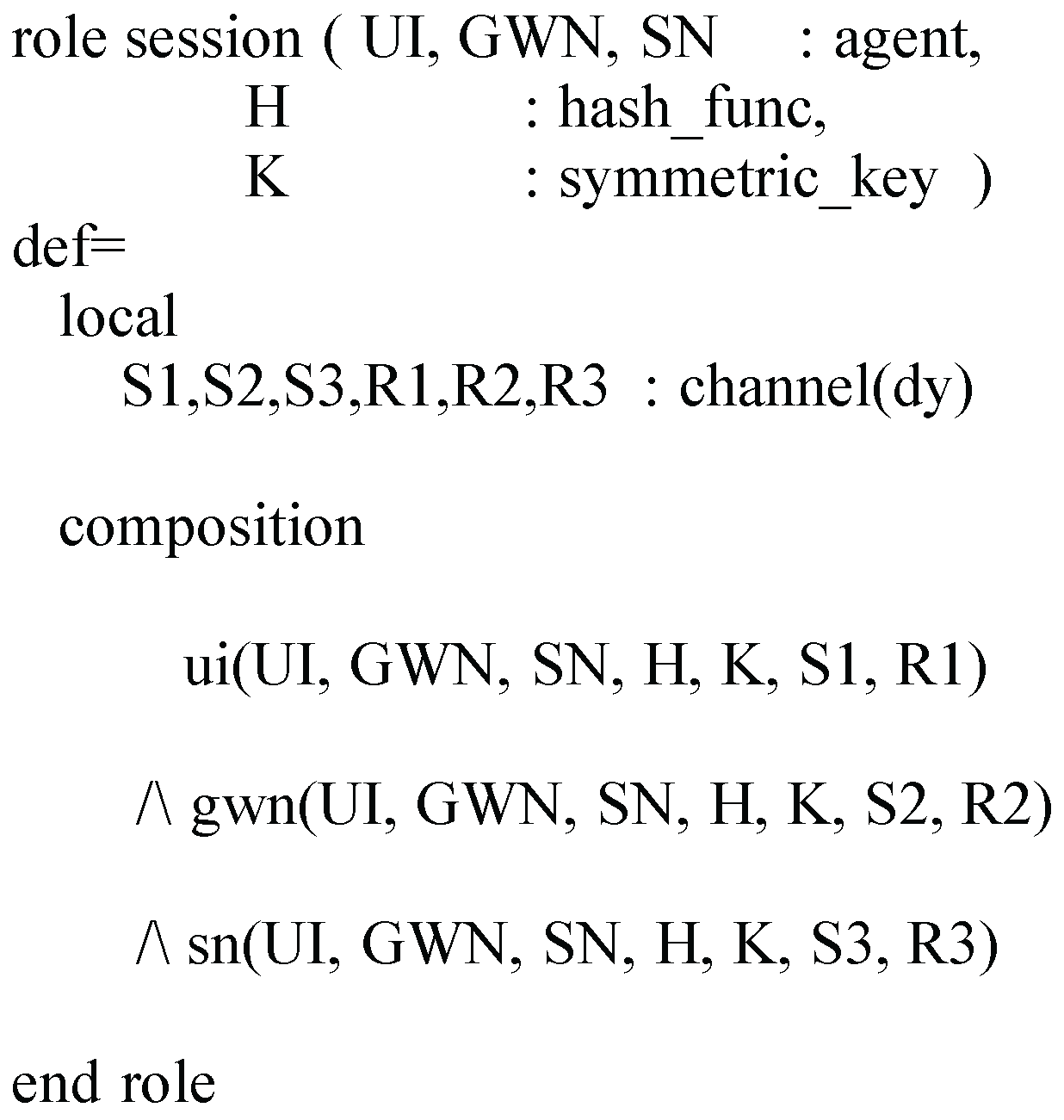
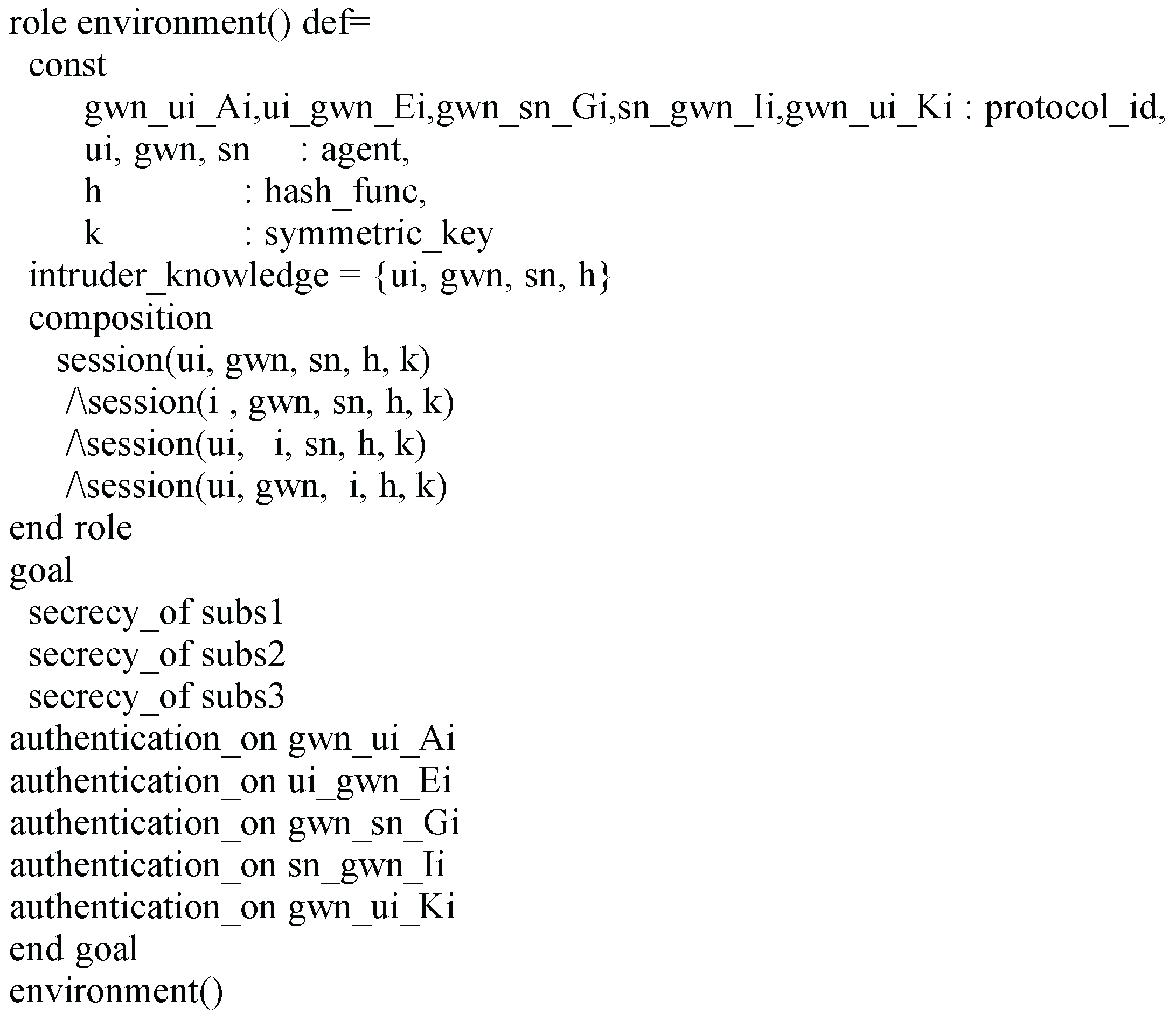
References
- Jiang, Q.; Ma, J.F.; Lu, X.; Tian, Y.L. An efficient two-factor user authentication scheme with unlinkability for wireless sensor networks. Peer-to-Peer Netw. Appl. 2015, 8, 1070–1081. [Google Scholar] [CrossRef]
- Wang, D.; Wang, P. On the anonymity of two-factor authentication schemes for wireless sensor networks: Attacks, principle and solutions. Comput. Netw. 2014, 73, 41–57. [Google Scholar] [CrossRef]
- He, D.B.; Zeadally, S.; Xu, B.W.; Huang, X.Y. An efficient identity-based conditional privacy-preserving authentication scheme for vehicular ad hoc networks. IEEE Trans. Inf. Forensics Secur. 2015, 10, 2681–2691. [Google Scholar] [CrossRef]
- Giri, D.; Maitra, T.; Amin, R.; Srivastava, P.D. An efficient and robust rsa-based remote user authentication for telecare medical information systems. J. Med. Syst. 2015, 39, 1–9. [Google Scholar] [CrossRef] [PubMed]
- Yeh, H.-L.; Chen, T.H.; Liu, P.C.; Kim, T.-H.; Wei, H.W. A secured authentication protocol for wireless sensor networks using elliptic curves cryptography. Sensors 2011, 11, 4767–4779. [Google Scholar] [CrossRef] [PubMed]
- Choi, Y.; Lee, D.; Kim, J.; Jung, J.; Nam, J.; Won, D. Security enhanced user authentication protocol for wireless sensor networks using elliptic curves cryptography. Sensors 2014, 14, 10081–10106. [Google Scholar] [CrossRef] [PubMed]
- Watro, R.; Kong, D.; Cuti, S.F.; Gardiner, C.; Lynn, C.; Kruus, P. Tinypk: Securing sensor networks with public key technology. In Proceedings of the 2nd ACM Workshopon Security of Ad Hoc and Sensor Networks (SASN’04), Washington, DC, USA, 25 October 2004; pp. 59–64.
- Wong, K.H.M.; Zheng, Y.; Cao, J.; Wang, S. A dynamic user authentication scheme for wireless sensor networks. In Proceedings of the 2006 IEEE International Conference on Sensor Networks, Ubiquitous, and Trustworthy Computing, Taichung, Taiwan, 5–7 June 2006.
- Das, M.L. Two-factor user authentication in wireless sensor networks. IEEE Trans. Wirel. Commun. 2009, 8, 1086–1090. [Google Scholar] [CrossRef]
- Nyang, D.; Lee, M.K. Improvement of Das’s two-factor authentication protocol in wireless sensor networks. IACR Cryptol. ePrint Arch. 2009, 2009, 631. [Google Scholar]
- Huang, H.-F.; Chang, Y.F.; Liu, C.H. Enhancement of two-factor user authentication in wireless sensor networks. In Proceedings of the 2010 Sixth International Conference on Intelligent Information Hiding and Multimedia Signal Processing, Darmstadt, Germany, 15–17 October 2010; pp. 27–30.
- Vaidya, B.; Makrakis, D.; Mouftah, H.T. Improved two-factor user authentication in wireless sensor networks. In Proceedings of the IEEE 6th International Conference on Wireless and Mobile Computing, Networking and Communications (WiMob), Niagara Falls, ON, Canada, 11–13 October 2010; pp. 600–606.
- Khan, M.K.; Alghathbar, K. Cryptanalysis and security improvements of two-factor userauthentication in wireless sensor networks. Sensors 2010, 10, 2450–2459. [Google Scholar] [CrossRef] [PubMed]
- He, D.J.; Gao, Y.; Chan, S.; Chen, C.; Bu, J.J. An enhanced two-factor user authentication scheme in wireless sensor networks. Ad Hoc Sens. Wirel. Netw. 2010, 10, 361–371. [Google Scholar]
- Das, A.K.; Sharma, P.; Chatterjee, S.; Sing, J.K. A dynamic password-based user authentication scheme for hierarchical wireless sensor networks. J. Netw. Comput. Appl. 2012, 35, 1646–1656. [Google Scholar] [CrossRef]
- Turkanović, M.; Hölbl, M. Notes on “a temporal-credential-based mutual authentication and key agreement scheme for wireless sensor networks”. Wirel. Pers. Commun. 2013, 77, 907–922. [Google Scholar]
- Wang, D.; Wang, P. Understanding security failures of two-factor authentication schemes for real-time applications in hierarchical wireless sensor networks. Ad Hoc Netw. 2014, 20, 1–15. [Google Scholar] [CrossRef]
- Li, C.-T.; Weng, C.-Y.; Lee, C.C. An advanced temporal credential-based security scheme with mutual authentication and key agreement for wireless sensor networks. Sensors 2013, 13, 9589–9603. [Google Scholar] [CrossRef] [PubMed]
- Xue, K.P.; Ma, C.S.; Hong, P.L.; Ding, R. A temporal-credential-based mutual authentication and key agreement scheme for wireless sensor networks. J. Netw. Comput. Appl. 2013, 36, 316–323. [Google Scholar] [CrossRef]
- He, D.B.; Kumar, N.; Chilamkurti, N. A secure temporal-credential-based mutual authentication and key agreement scheme with pseudo identity for wireless sensor networks. Inform. Sci. 2015, 321, 263–277. [Google Scholar] [CrossRef]
- Turkanović, M.; Brumen, B.; Hölbl, M. A novel user authentication and key agreement scheme for heterogeneous ad hoc wireless sensor networks, based on the Internet of Things notion. Ad Hoc Netw. 2014, 20, 96–112. [Google Scholar]
- Chang, C.C.; Le, H.D. A provably secure, efficient, and flexible authentication scheme for ad hoc wireless sensor networks. IEEE Trans. Wirel. Commun. 2016, 15, 357–366. [Google Scholar] [CrossRef]
- Farash, M.S.; Turkanović, M.; Kumari, S.; Hölbl, M. An efficient user authentication and key agreement scheme for heterogeneous wireless sensor network tailored for the Internet of Things environment. Ad Hoc Netw. 2016, 36, 152–176. [Google Scholar] [CrossRef]
- Amin, R.; Biswas, G.P. A secure lightweight scheme for user authentication and key agreement in multi-gateway based wireless sensor networks. Ad Hoc Netw. 2015, 20, 1–23. [Google Scholar]
- Cheng, Z.; Nistazakis, M.; Comley, R.; Vasiu, L. On the in distinguishability-based security model of key agreement protocols-simple cases. IACR Cryptology ePrint Arch. 2005, 2005, 129. [Google Scholar]
- Blake-Wilson, S.; Johnson, D.; Menezes, A. Key agreement protocols and their security analysis. In Proceedings of the Sixth IMA International Conference on Cryptography and Coding, Cirencester, UK, 17–19 December 1997.
- Bonneau, J. The science of guessing: Analyzing an anonymized corpus of 70 million passwords. In Proceedings of the 33th IEEE Symposium on Security and Privacy (S&P 2012), San Francisco, CA, USA, 20–23 May 2012; pp. 538–552.
- Dell’Amico, M.; Michiardi, P.; Roudier, Y. Password strength: An empirical analysis. In Proceedings of the 29th IEEE Conference on Computer Communications (INFOCOM 2010), San Diego, CA, USA, 14–19 March 2010; pp. 1–9.
- Burrow, M.; Abadi, M.; Needham, R. A logic of authentication. ACM Trans. Comput. Syst. 1990, 8, 18–36. [Google Scholar] [CrossRef]
- AVISPA, Automated Validation of Internet Security Protocols and Applications. Available online: http://www.avispa-project.org/ (accessed on 6 June 2016).
- AVISPA, AVISPA Web Tool. Available online: http://www.avispa-project.org/web-interface/expert.php/ (accessed on 6 June 2016).
- Dolev, D.; Yao, A.C. On the Security of Public Key Protocols. IEEE Trans. Inform. Theory 1983, 29, 198–208. [Google Scholar] [CrossRef]
- Advanced Encryption Standard, FIPS PUB 197, National Institute of Standards and Technology (NIST), U.S. Department of Commerce. Available online: http://csrc.nist.gov/publications/fips/fips197/fips-197.pdf (accessed on 6 June 2016).
- SHA-3 Standardization. NIST. Available online: http://csrc.nist.gov/groups/ST/hash/sha-3/sha-3-standardization.html (accessed on 6 June 2016).
- Java Pairing Based Cryptography Library (JPBC). Available online: http://gas.dia.unisa.it/projects/jpbc (accessed on 6 June 2016).
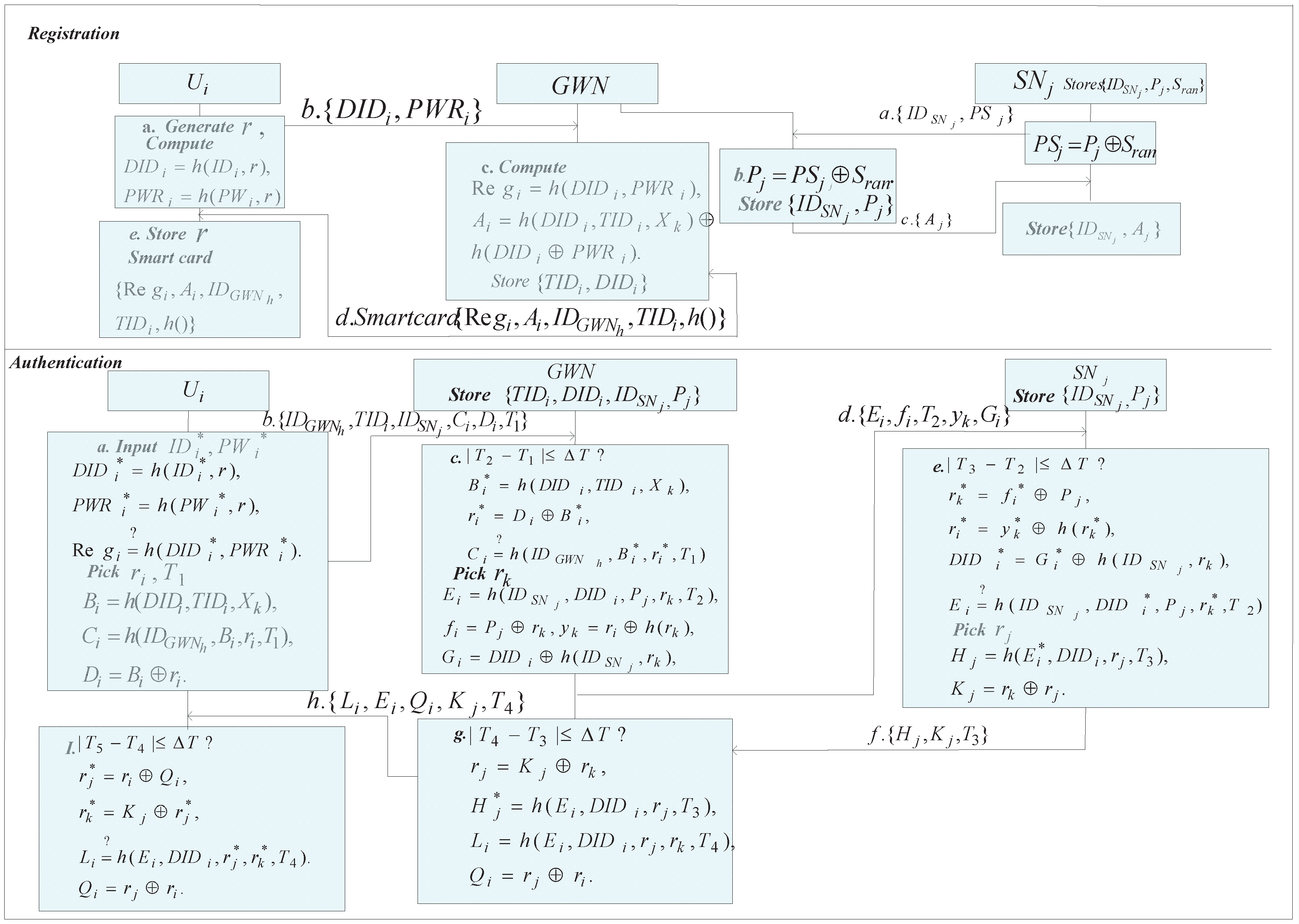
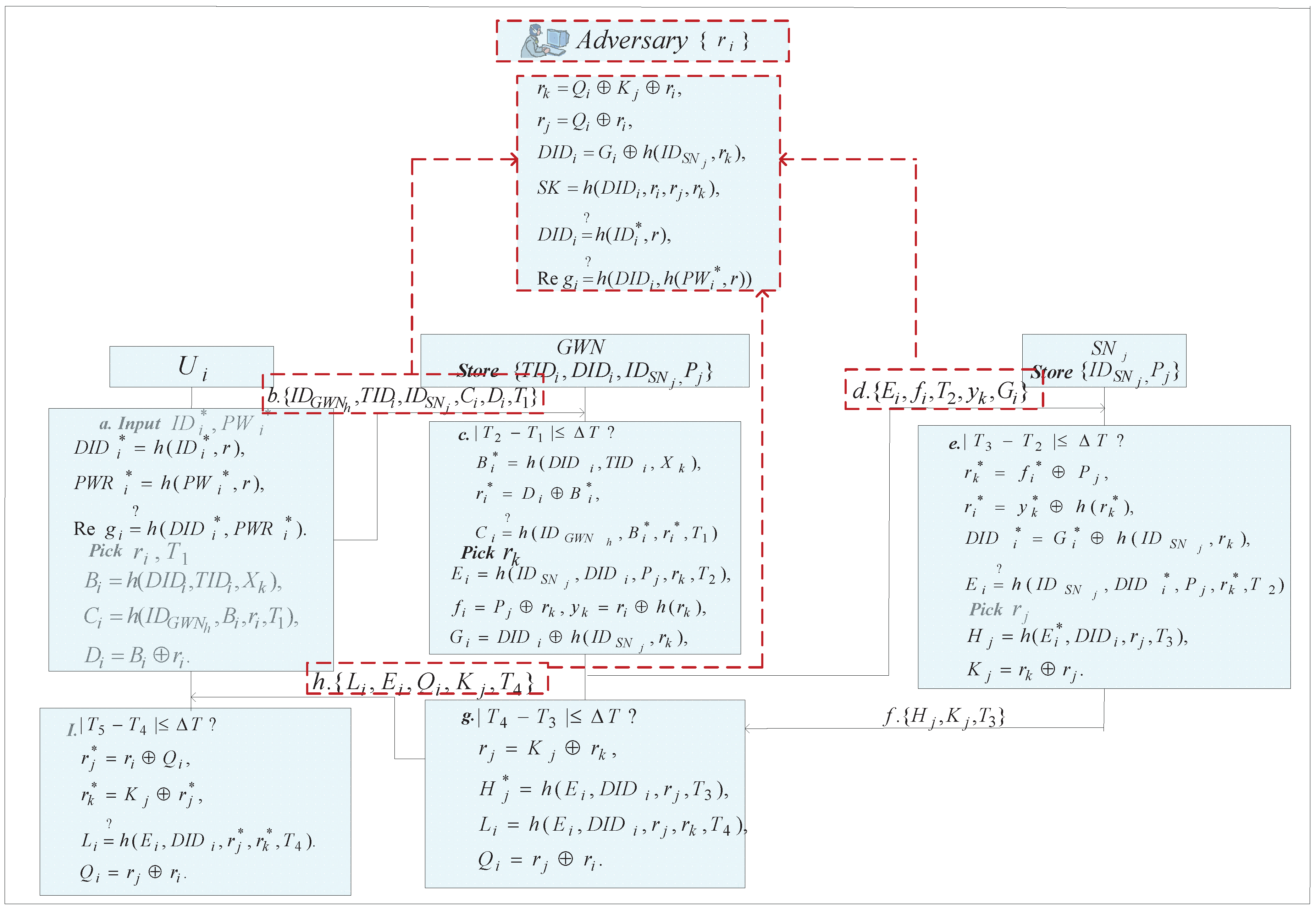
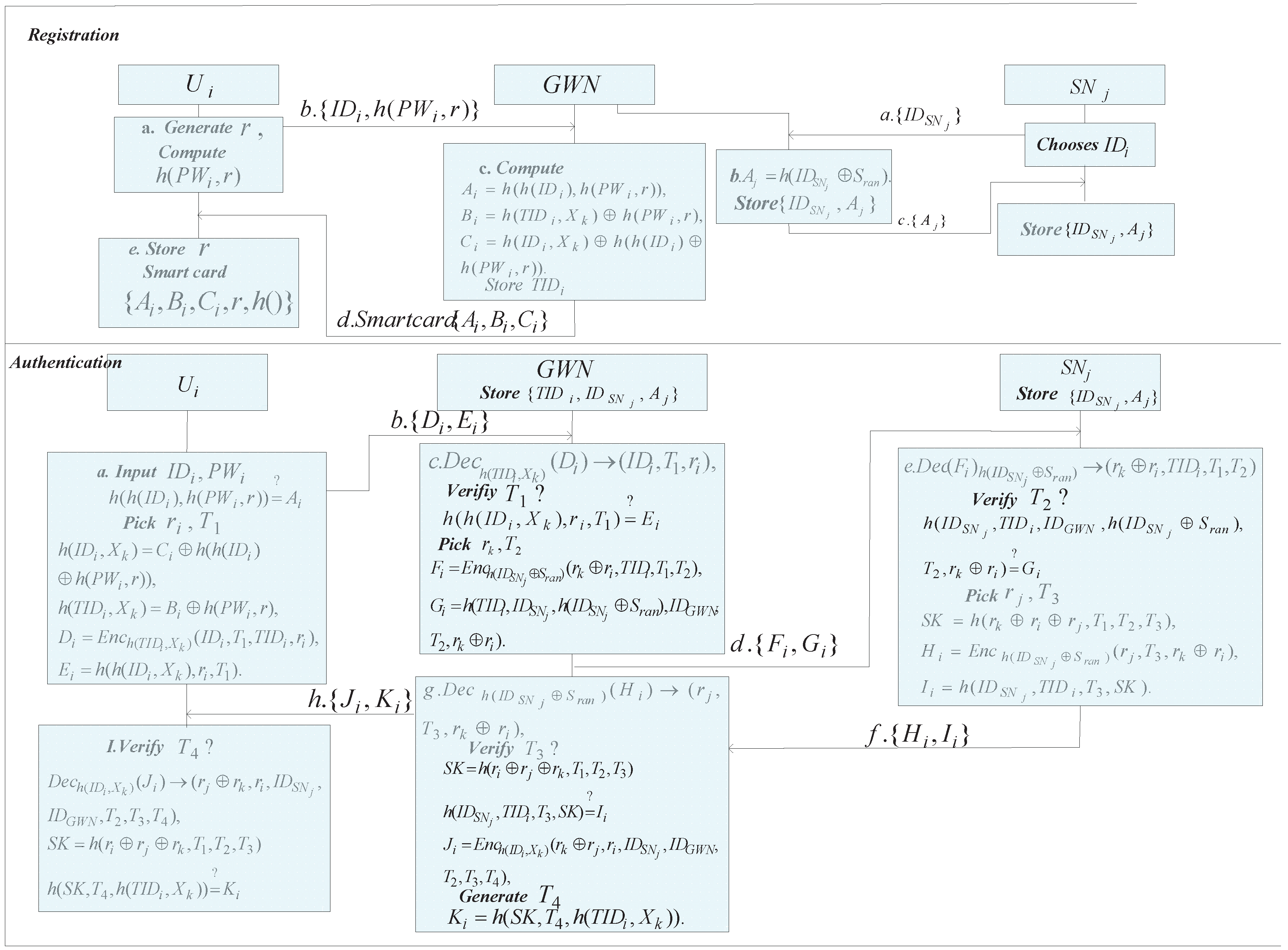
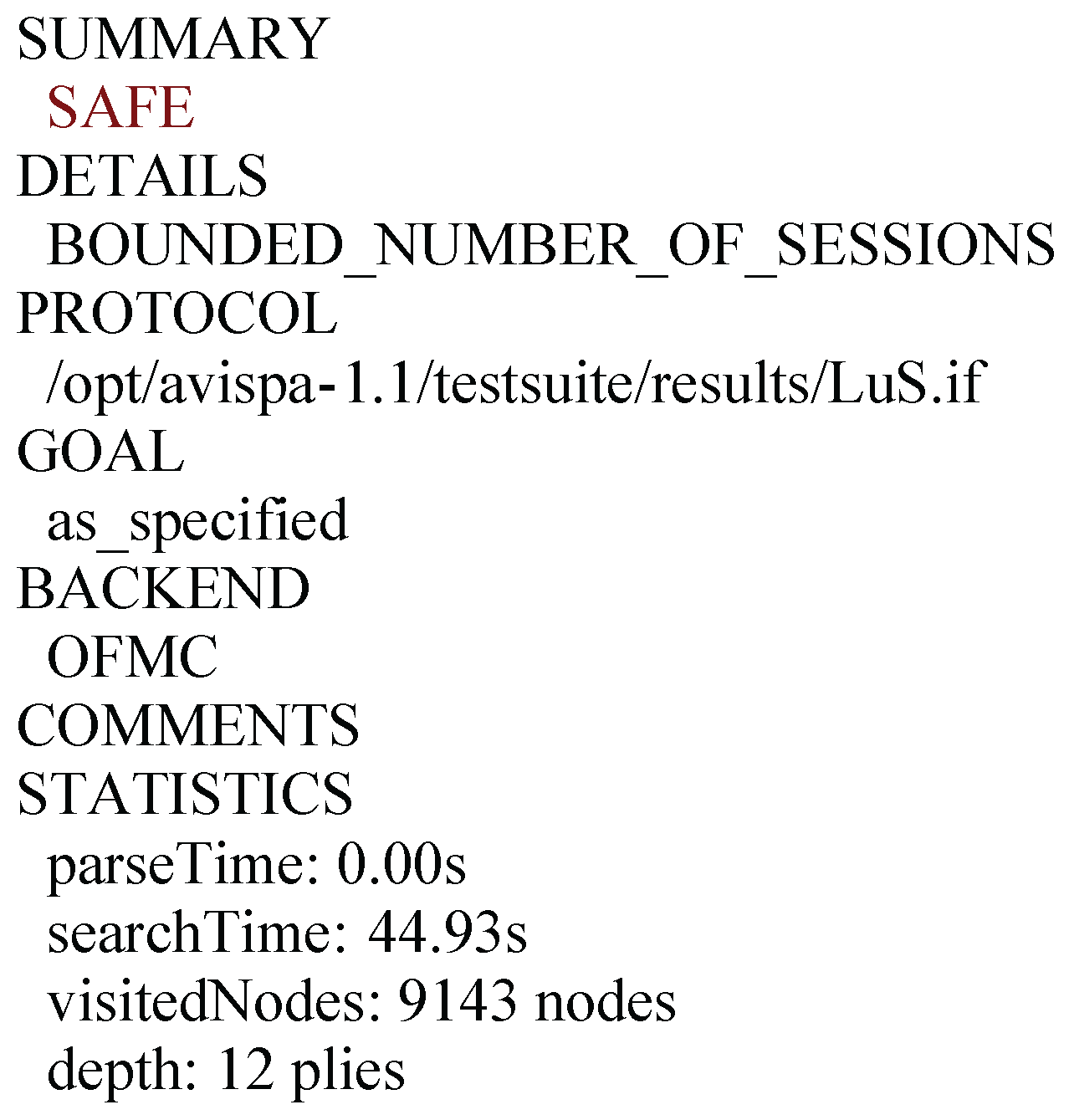
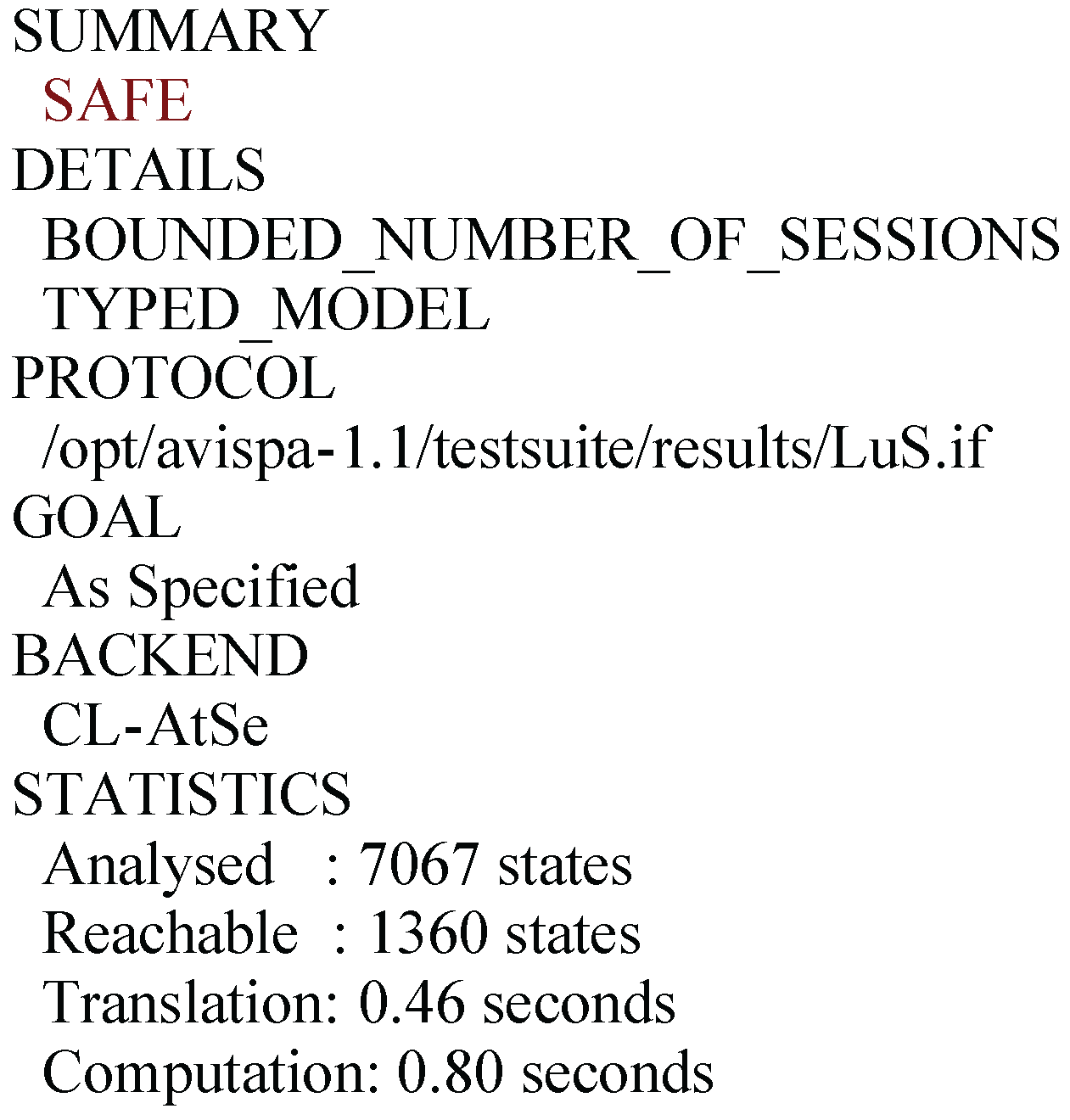
| Symbol | Description |
|---|---|
| User | |
| Gateway node | |
| Sensor node | |
| Home gateway node | |
| Identity/Password of | |
| Random identity of generated by for authentication | |
| Identity of | |
| Secret key of | |
| Constant transmission time | |
| Timestamp | |
| r/ | Random numbers of |
| One-way hash function | |
| ⊕ | Xor operation |
| Ours | Aim-Biswas [24] | Farash et al. [23] | Turkanović et al. [21] | Xue et al. [19] | |
|---|---|---|---|---|---|
| Communication cost (bits) | 3680 | 3808 | 3808 | 2816 | 3212 |
| Computation cost (user) | |||||
| Computation cost (sensor) | |||||
| Computation cost (GWN) | |||||
| Total (ms) | |||||
| Yes | Yes | Yes | Yes | ||
| Yes | Yes | Yes | Yes | Yes | |
| Yes | Yes | Yes | Yes | ||
| Yes | Yes | Yes | Yes | Yes | |
| Yes | Yes | Yes | Yes | ||
| Yes | Yes | Yes |
© 2016 by the authors; licensee MDPI, Basel, Switzerland. This article is an open access article distributed under the terms and conditions of the Creative Commons Attribution (CC-BY) license (http://creativecommons.org/licenses/by/4.0/).
Share and Cite
Lu, Y.; Li, L.; Peng, H.; Yang, Y. An Energy Efficient Mutual Authentication and Key Agreement Scheme Preserving Anonymity for Wireless Sensor Networks. Sensors 2016, 16, 837. https://doi.org/10.3390/s16060837
Lu Y, Li L, Peng H, Yang Y. An Energy Efficient Mutual Authentication and Key Agreement Scheme Preserving Anonymity for Wireless Sensor Networks. Sensors. 2016; 16(6):837. https://doi.org/10.3390/s16060837
Chicago/Turabian StyleLu, Yanrong, Lixiang Li, Haipeng Peng, and Yixian Yang. 2016. "An Energy Efficient Mutual Authentication and Key Agreement Scheme Preserving Anonymity for Wireless Sensor Networks" Sensors 16, no. 6: 837. https://doi.org/10.3390/s16060837






